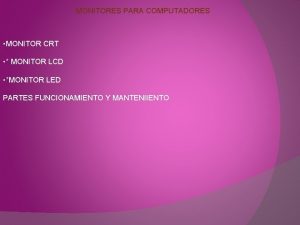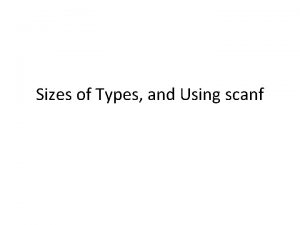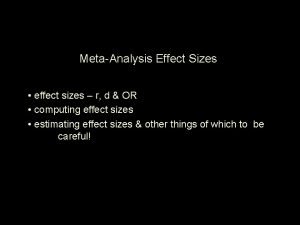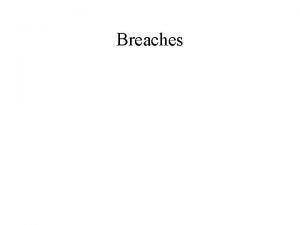Monitor Sizes Monitor sizes in the US are












- Slides: 12

Monitor Sizes • Monitor sizes in the US are measured in inches, diagonal distance. 20” (inches)

Aspect Ratio • 4: 3 is most common 16: 12 • 16: 10 is common for wide screens 16 20” (inches) 12 16 10 18. 87” (inches)

Aspect Ratio • 5: 4 is common for LCD’s (non-widescreen) 15 19” (inches) 12 16 10 18. 87” (inches)

PPI / DPI • Displays: Pixels Per Inch – 60, 72, 96 are common • Printers: Dots Per Inch – 300, 600, 1200 are common • 96 X 15 = 1440 px wide • 96 X 12 = 1152 px high 1440 px wide 15” 19” (inches) 12”

Over-Sampling 7 Megapixel photo • 2880× 2304 5: 4 6, 635, 520 pixels. • 32 -bit color 2^32 = 4 billion different colors – 4 bytes per pixel • Grand total 24+ Megabyte file without compression. • What happens when you display this image full-screen on this monitor? 1440 px wide 15” 19” (inches) 12”

Over-Sampling • Original Picture • What you really see on a 19” monitor.

Printing • 600 DPI printing • How much resolution? 11” X 8. 5” • 600 X 11 = 66, 000 dot or pixels across

Under-sampling • Original Picture • What you see on printed photograph Original picture could have been sampled at a higher rate and the printed version would look better.

Printing Issues? • Is over sampling ever an issue when your output is a printed photo? • Even though most digital photos (10 Megabits or smaller) are under-sampled, why doesn’t it matter?

Crux of over-sampling? Device perspective: • What the device can produce in terms of resolution. Human perspective: • What the human can perceive with the naked eye. • 600 DPI is necessary for printing fonts, • 600 DPI is overkill for printing photographs. • Why?

Resolution Depends on Content • Fonts are in fact vector-based, limitless resolution. • Fonts have smooth curves • Human eye can see jaggies in fonts are 120 DPI. • Photographs have blended colors and gradients. • Unless there are miniscule details, Human eye can not see jaggies in photos that are 120 DPI.

Practical Advice • Modern digital photography (10 Megapixels) is way ahead of display resolution. • However, modern digital photography is still behind of print resolution. • Unless you are going to print, 5+Mp is enough. • Example: 8 X 10 vs 16 X 20.
 Mikael ferm
Mikael ferm Men's shirt sizes are determined by their neck sizes
Men's shirt sizes are determined by their neck sizes Common monitor sizes
Common monitor sizes Thiếu nhi thế giới liên hoan
Thiếu nhi thế giới liên hoan Alleluia hat len nguoi oi
Alleluia hat len nguoi oi điện thế nghỉ
điện thế nghỉ Phối cảnh
Phối cảnh Một số thể thơ truyền thống
Một số thể thơ truyền thống Sơ đồ cơ thể người
Sơ đồ cơ thể người Công thức tính độ biến thiên đông lượng
Công thức tính độ biến thiên đông lượng Số nguyên là gì
Số nguyên là gì đặc điểm cơ thể của người tối cổ
đặc điểm cơ thể của người tối cổ Tỉ lệ cơ thể trẻ em
Tỉ lệ cơ thể trẻ em























